Differential Sampling of AC Waveforms Based on a Commercial Digital-to-Analog Converter for Reference
Abstract
1. Introduction
- (1)
- A differential sampling system with a commercial DAC for reference has been developed. A combined uncertainty of 1 part in 106 (k = 2) was archived with a frequency of 50 Hz and an amplitude of 1 V.
- (2)
- Large AC signal measurements are converted into large DC signal measurements and small AC signal measurements. The Keysight 3458A is excellent for DC voltage measurement. The experiment proves that measuring small voltages provides greater accuracy than large voltages with the same aperture time, making this differential sampling method more stable and accurate than direct sampling measurement.
- (3)
- The reference voltage is determined through a static measurement method rather than dynamically sampled, leading to a notable enhancement in the stability and precision of measurements.
- (4)
- The uncertainty propagation model of DFT is derived, which is quite important for measurement procedure design and the uncertainty estimation of the final result.
2. Accurate Measurement of Reference Voltage
2.1. A Static Measurement Method to Measure Reference Voltage
2.2. Drift of the DAC Output
3. Differential Sampling with Integrating Sampler
3.1. System and Setup
3.2. Aperture Time
3.3. Number of Measurement Cycles
4. Measurements
- (a)
- The aperture time of the sampling voltmeter;
- (b)
- The phase alignment between the calibrator sine wave and the DAC stepwise approximated waveform;
- (c)
- The number of steps of the DAC waveform per period.
5. Uncertainty Evaluation
5.1. Evaluation of the Sampler
5.2. Evaluation of the DAC and the Calibrator
6. Conclusions
Author Contributions
Funding
Institutional Review Board Statement
Informed Consent Statement
Data Availability Statement
Conflicts of Interest
References
- Espel, P.; Poletaeff, A.; Bounouh, A. Characterization of analogue-to-digital converters of a commercial digital voltmeter in the 20 Hz to 400 Hz frequency range. Metrologia 2009, 46, 578–584. [Google Scholar] [CrossRef]
- Pan, X.; Zhang, J.; Shi, Z.; He, Q.; Lin, J. Establishment of AC power standard at frequencies up to 100 kHz. Measurement 2018, 125, 151–155. [Google Scholar] [CrossRef]
- Shi, Z.; Wang, Z.; Zhang, J.; Pan, X.; Wang, L.; Song, Y. AC–DC Transfer and Verification of Ultra-Low Frequency Voltage From 0.1 to 10 Hz. IEEE Trans. Instrum. Meas. 2023, 72, 1501207. [Google Scholar] [CrossRef]
- Behr, R.; Palafox, L.; Ramm, G.; Moser, H.; Melcher, J. Direct Comparison of Josephson Waveforms Using an AC Quantum Voltmeter. IEEE Trans. Instrum. Meas. 2007, 56, 235–238. [Google Scholar] [CrossRef]
- Filipski, P.S.; van den Brom, H.E.; Houtzager, E. International comparison of quantum AC voltage standards for frequencies up to 100kHz. Measurement 2012, 45, 2218–2225. [Google Scholar] [CrossRef]
- Trinchera, B.; Serazio, D.; Durandetto, P.; Oberto, L.; Fasolo, L. Development of a PJVS system for quantum-based sampled power measurements. Measurement 2023, 219, 113275. [Google Scholar] [CrossRef]
- Rüfenacht, A.; Burroughs, C.J.; Benz, S.P. Precision sampling measurements using ac programmable Josephson voltage standards. Rev. Sci. Instrum. 2008, 79, 044704. [Google Scholar] [CrossRef]
- Rufenacht, A.; Burroughs, C.J.; Benz, S.P.; Dresselhaus, P.D.; Waltrip, B.; Nelson, T. Precision differential sampling measurements of low frequency voltages synthesized with an AC Programmable Josephson Voltage Standard. In Proceedings of the 2008 Conference on Precision Electromagnetic Measurements (CPEM 2008), Broomfield, CO, USA, 8–13 June 2008; pp. 70–71. [Google Scholar]
- Jia, Z.; Liu, Z.; Wang, L.; He, Q.; Huang, H.; Liu, L. Design and implementation of differential AC voltage sampling system based on PJVS. Measurement 2018, 125, 606–611. [Google Scholar] [CrossRef]
- Rüfenacht, A.; Burroughs, C.J.; Dresselhaus, P.D.; Benz, S.P. Differential Sampling Measurement of a 7 V RMS Sine Wave with a Programmable Josephson Voltage Standard. IEEE Trans. Instrum. Meas. 2013, 62, 1587–1593. [Google Scholar] [CrossRef]
- Lee, J.; Behr, R.; Palafox, L.; Katkov, A.; Schubert, M.; Starkloff, M.; Böck, A.C. An ac quantum voltmeter based on a 10 V programmable Josephson array. Metrologia 2013, 50, 612–622. [Google Scholar] [CrossRef]
- Chen, S.-F.; Amagai, Y.; Maruyama, M.; Kaneko, N.-H. Uncertainty Evaluation of a 10 V RMS Sampling Measurement System Using the AC Programmable Josephson Voltage Standard. IEEE Trans. Instrum. Meas. 2015, 64, 3308–3314. [Google Scholar] [CrossRef]
- Kim, M.-S.; Cho, H.; Chayramy, R.; Solve, S. Measurement configurations for differential sampling of AC waveforms based on a programmable Josephson voltage standard: Effects of sampler bandwidth on the measurements. Metrologia 2020, 57, 065020. [Google Scholar] [CrossRef]
- Rado Lapuh, Sampling with 3458A (Slovenija: Tiskarna Knjigoveznica Radovljica d.o.o). Available online: https://www.amtest-tm.com/en/product/r-lapuh-sampling-with-3458a-isbn-978-961-94476-0-4/ (accessed on 22 March 2024).
- Witt, T.J. Using the autocorrelation function to characterize time series of voltage measurements. Metrologia 2007, 44, 201–209. [Google Scholar] [CrossRef]
- Crotti, G.; Giordano, D.; Luiso, M.; Pescetto, P. Improvement of Agilent 3458A Performances in Wideband Complex Transfer Function Measurement. IEEE Trans. Instrum. Meas. 2017, 66, 1108–1116. [Google Scholar] [CrossRef]
- Swerlein, R. A 10 ppm Accurate Digital ac Measurement Algorithm. In Proceedings of the NCSL Workshop & Symposium, Albuquerque, NM, USA, 19–22 August 1991; pp. 17–36. [Google Scholar]
- Yang, Y.; Huang, L.; Lu, Z.; Lu, W. AC Voltage Reference Using the Fundamental of DAC Stepwise-Approximated Sine Waves. IEEE Trans. Instrum. Meas. 2013, 63, 473–478. [Google Scholar] [CrossRef]
- Ihlenfeld, W.G.K. Maintenance and Traceability of AC Voltages by Syn-Chronous Digital Synthesis and Sampling; Technical Report; PTB-Bericht PTB-E-75: Braunschweig, Germany, 2001. [Google Scholar]
- Zhou, K.; Qu, J.; Dong, X. Low crest factor multitone waveform synthesis with the AC Josephson voltage standard. In Proceedings of the 2015 IEEE International Instrumentation and Measurement Technology Conference (I2MTC), Pisa, Italy, 11–14 May 2015; pp. 556–559. [Google Scholar]
- Brom, H.E.v.d.; Houtzager, E.; Rietveld, G.; van Bemmelen, R.; Chevtchenko, O. Voltage linearity measurements using a binary Josephson system. Meas. Sci. Technol. 2007, 18, 3316–3320. [Google Scholar] [CrossRef]
- Kim, M.-S.; Kim, K.-T.; Kim, W.-S.; Chong, Y.; Kwon, S.-W. Analog-to-digital conversion for low-frequency waveforms based on the Josephson voltage standard. Meas. Sci. Technol. 2010, 21, 115102. [Google Scholar] [CrossRef]
- Kim, M.-S.; Cho, H.; Solve, S. Differential sampling of AC waveforms based on a programmable Josephson voltage standard using a high-precision sampler. Metrologia 2022, 59, 015006. [Google Scholar] [CrossRef]
- Behr, R.; Kieler, O.F.O.; Schleubner, D.; Palafox, L.; Ahlers, F.-J. Combining Josephson Systems for Spectrally Pure AC Waveforms With Large Amplitudes. IEEE Trans. Instrum. Meas. 2013, 62, 1634–1639. [Google Scholar] [CrossRef]

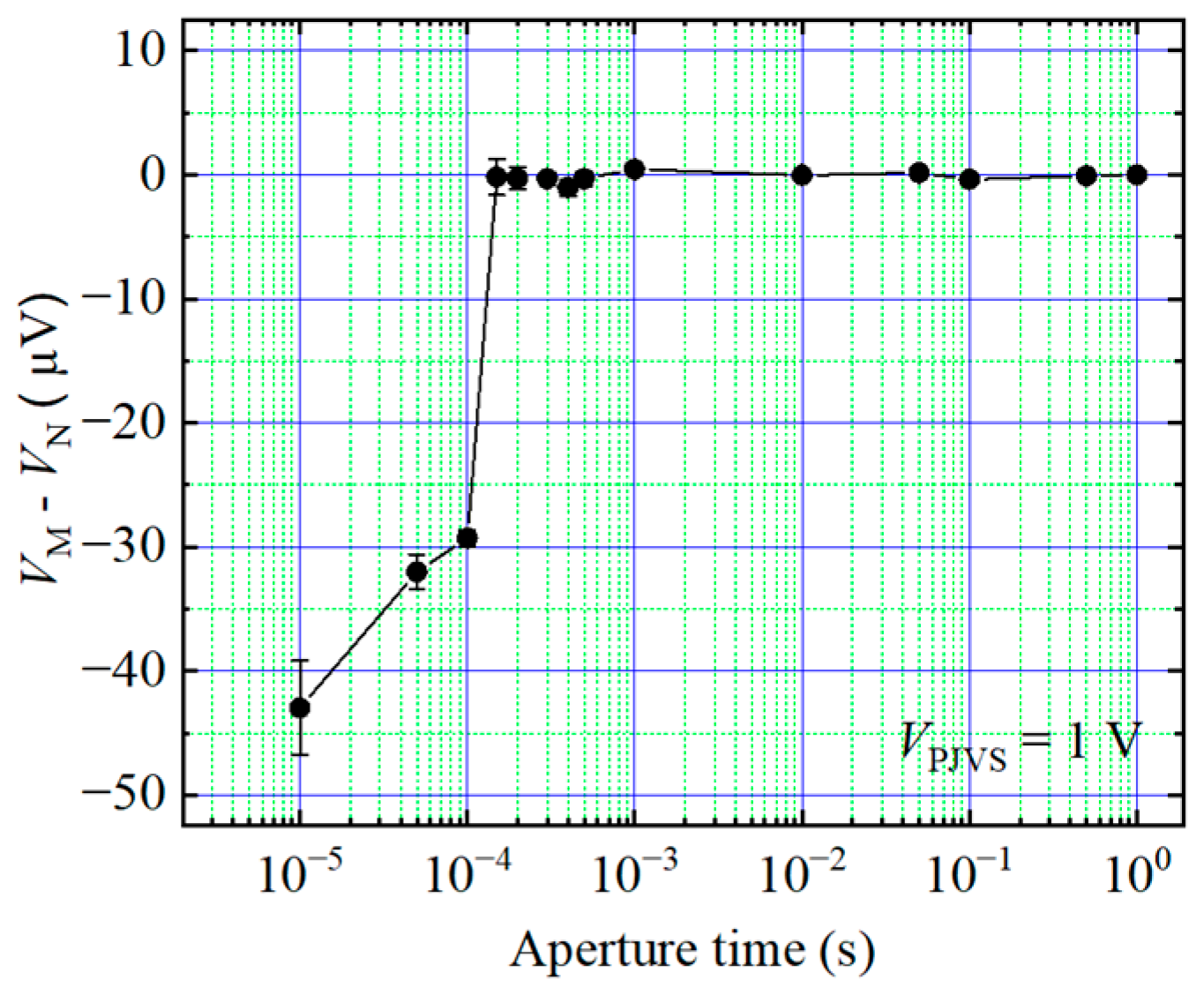
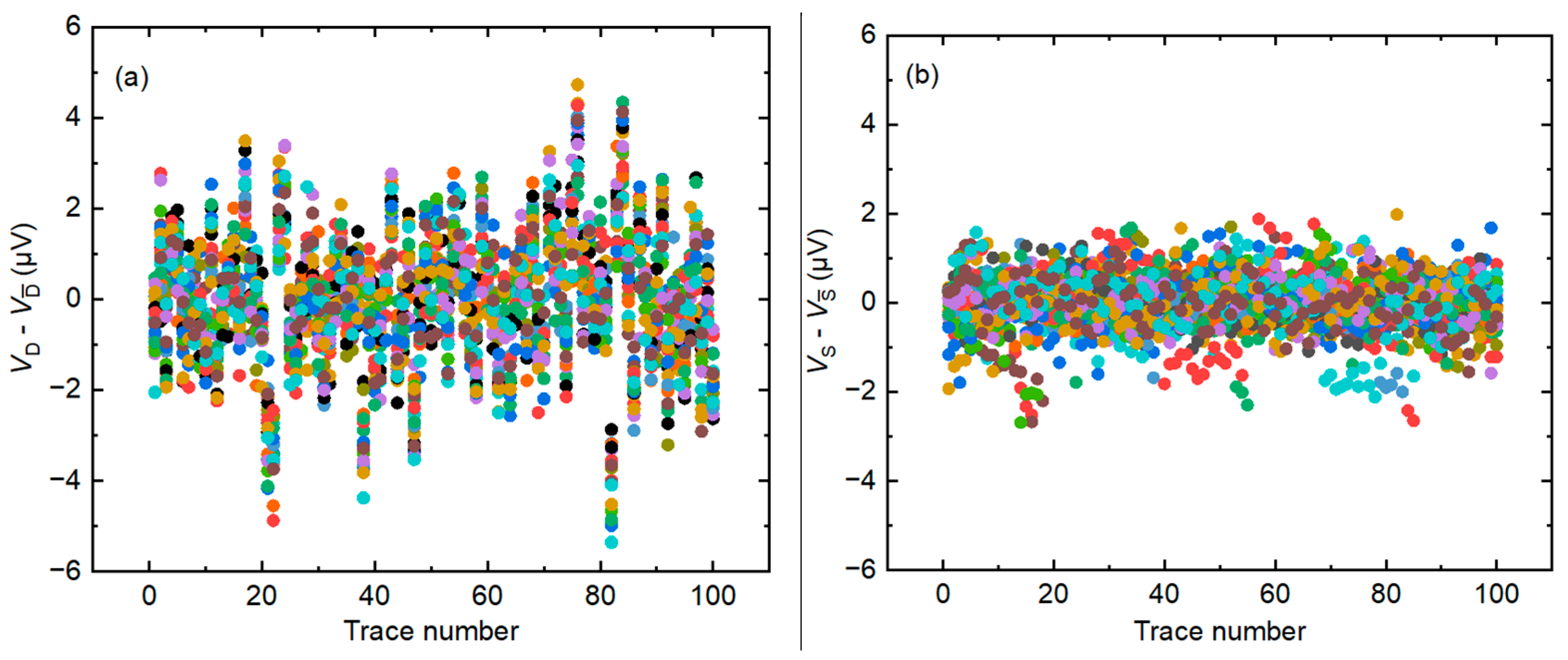
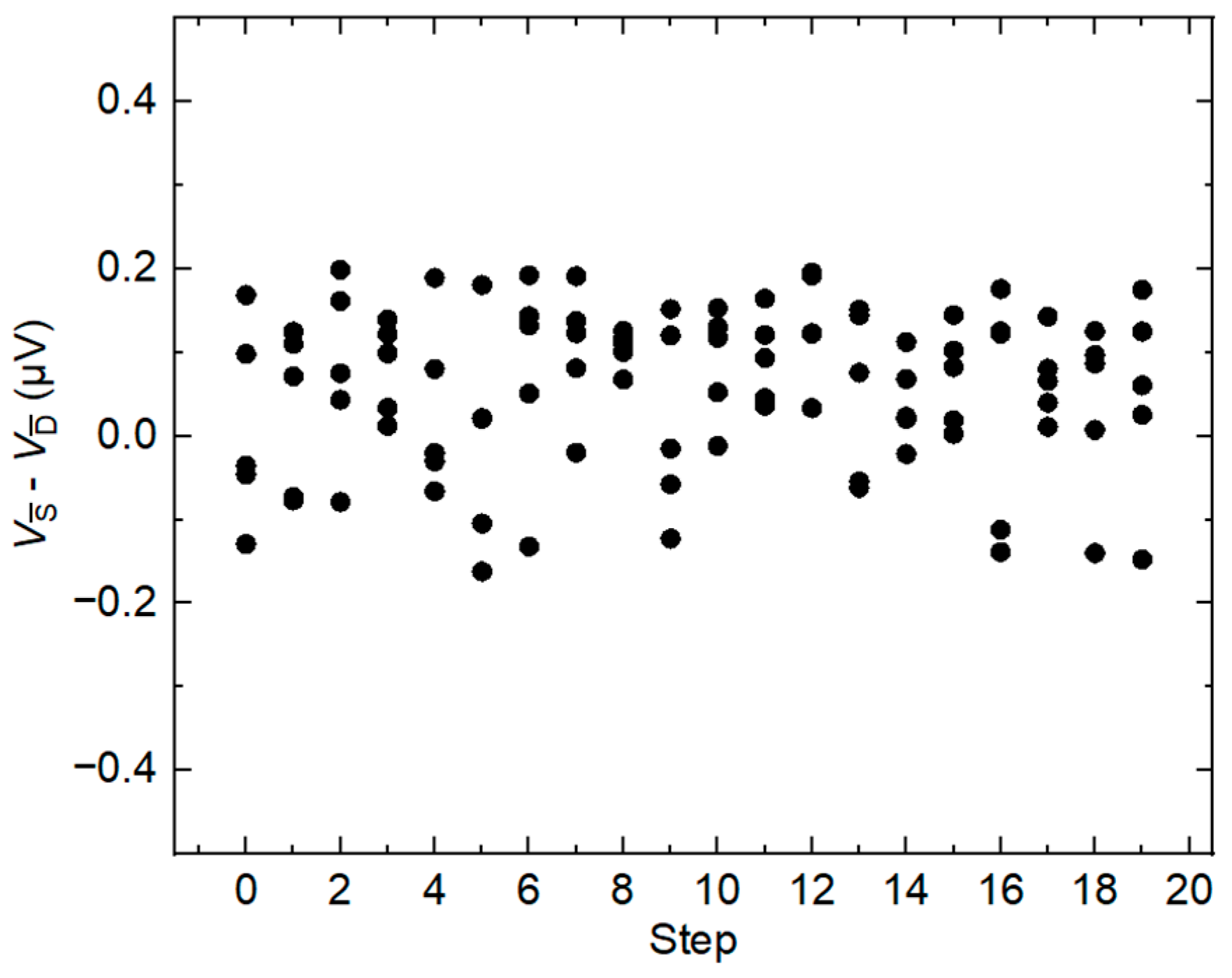

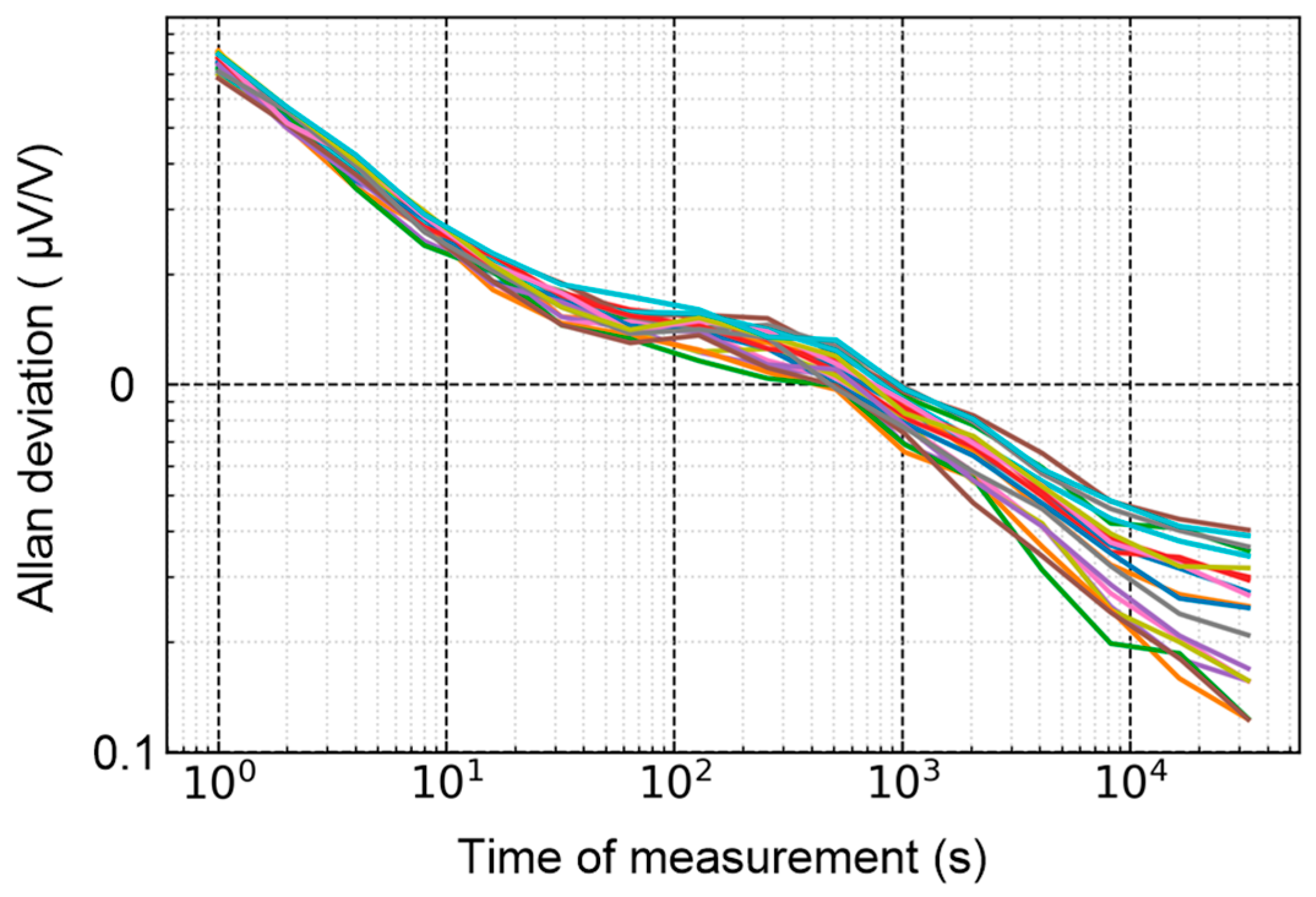
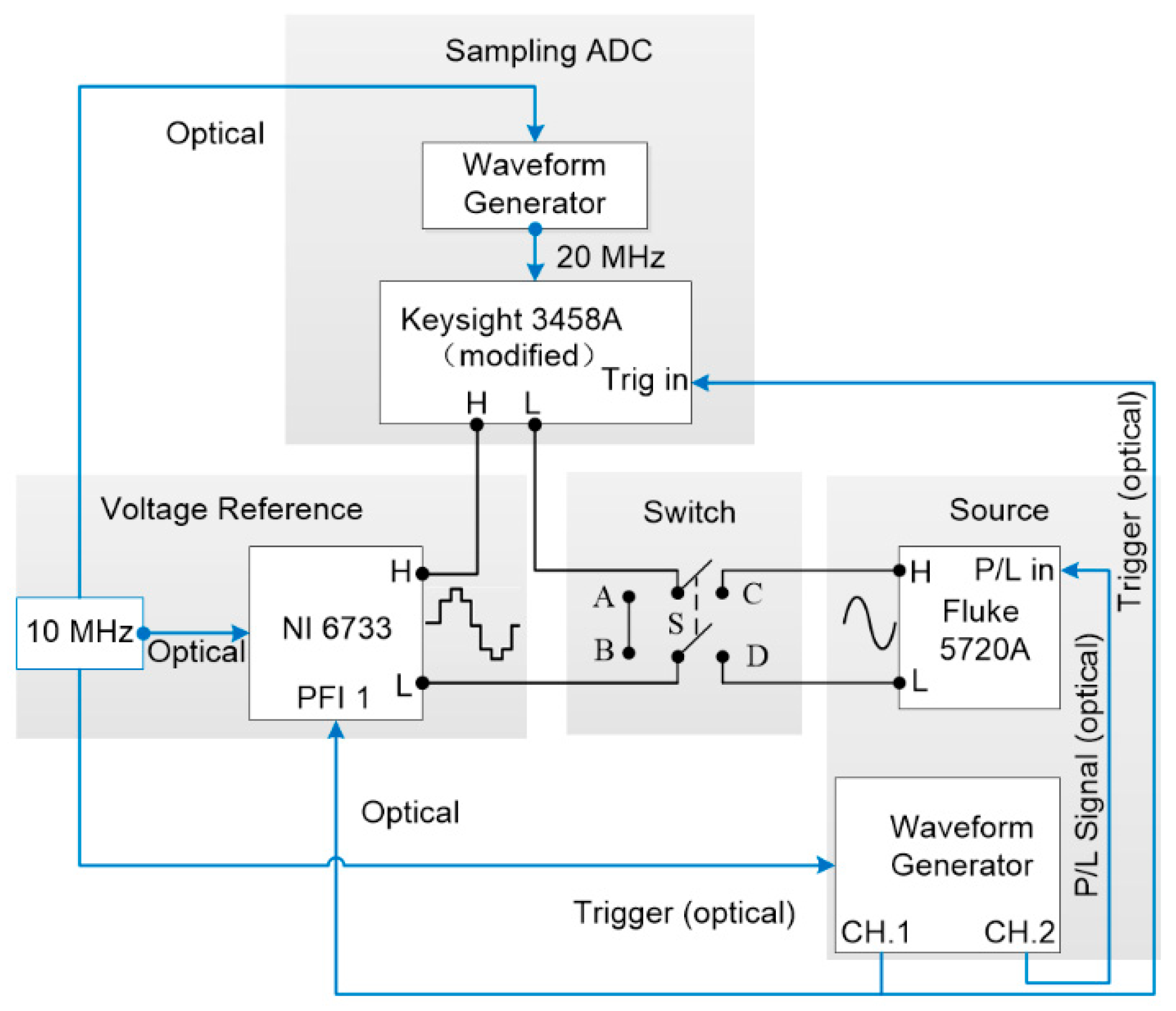


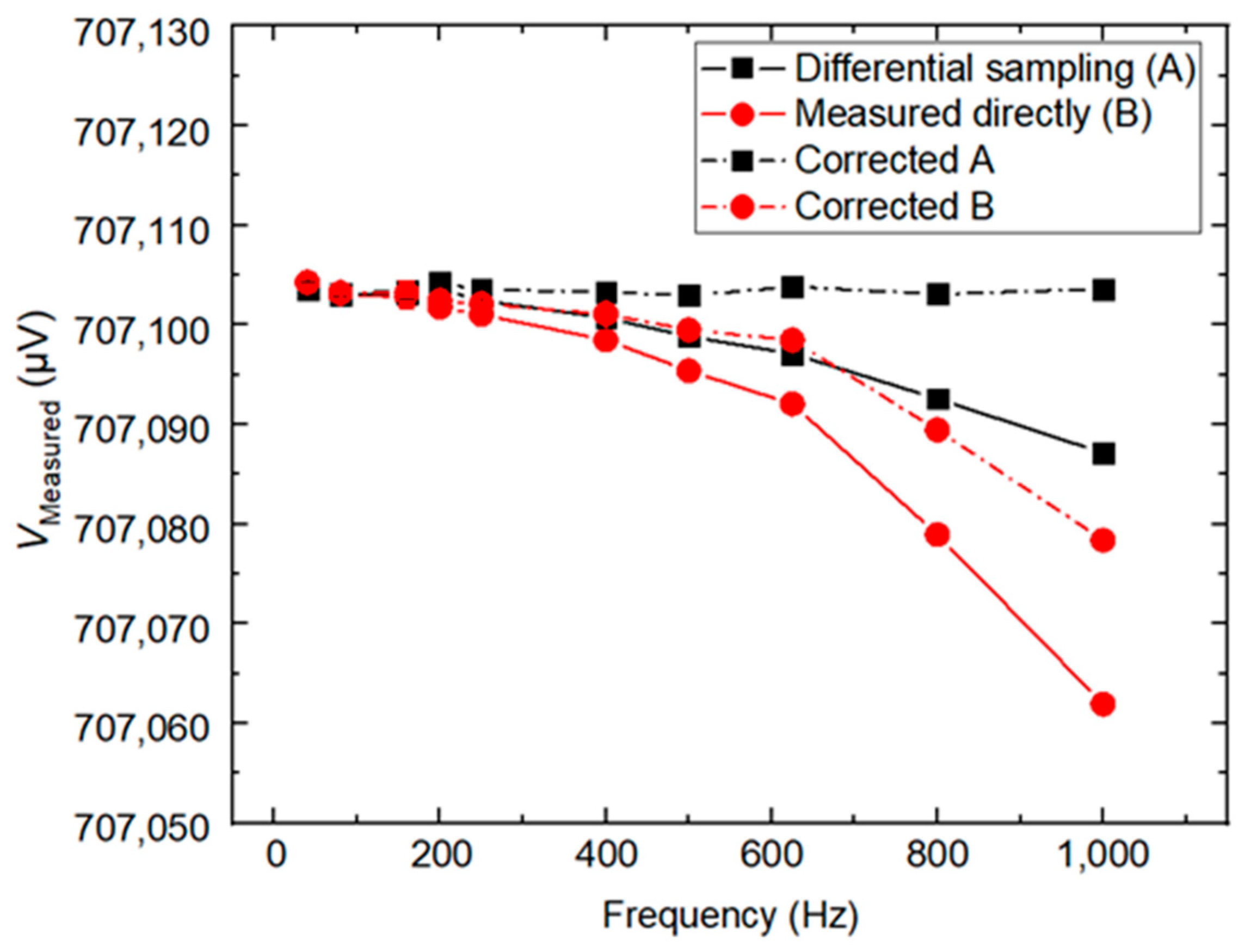

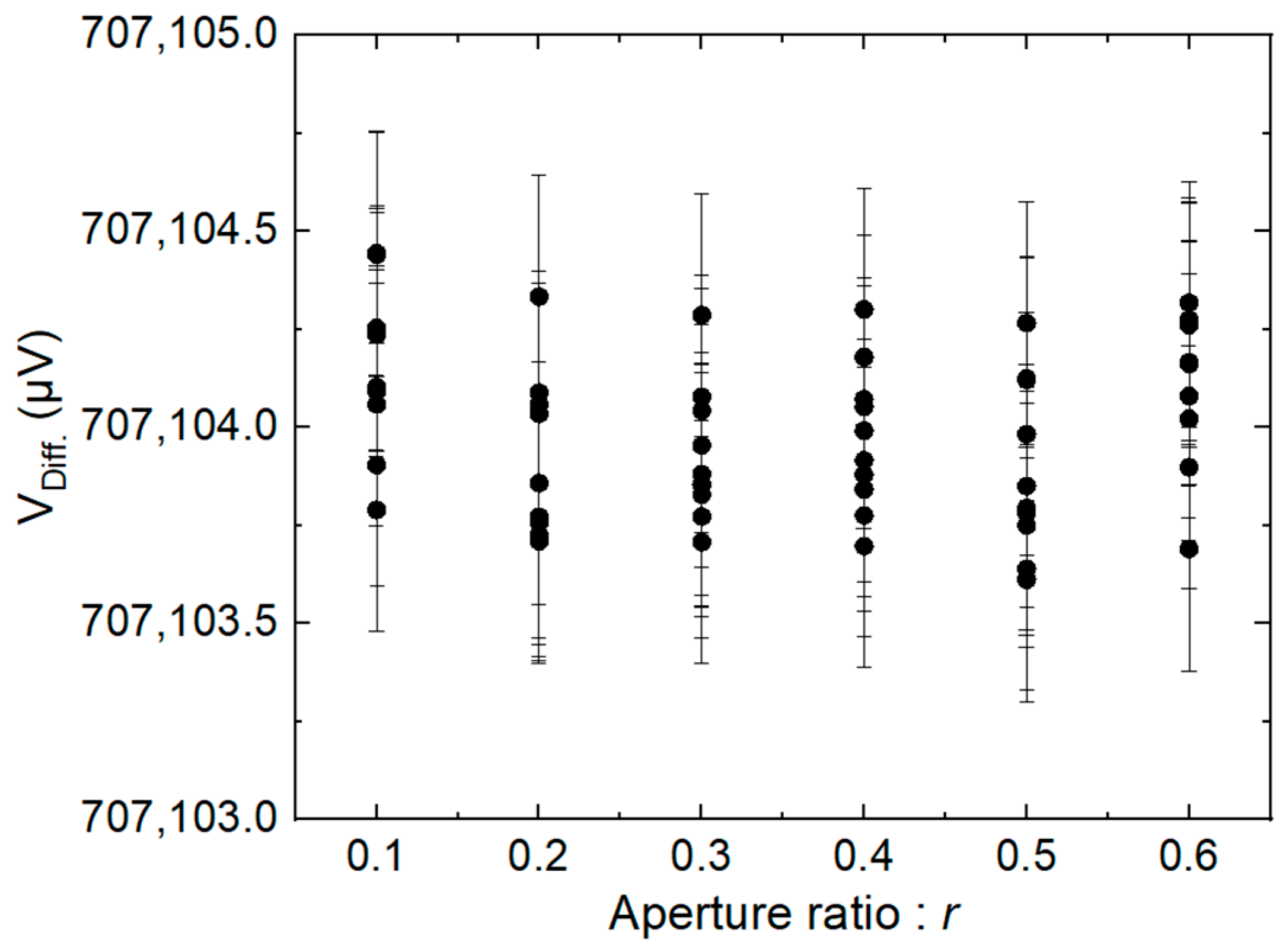
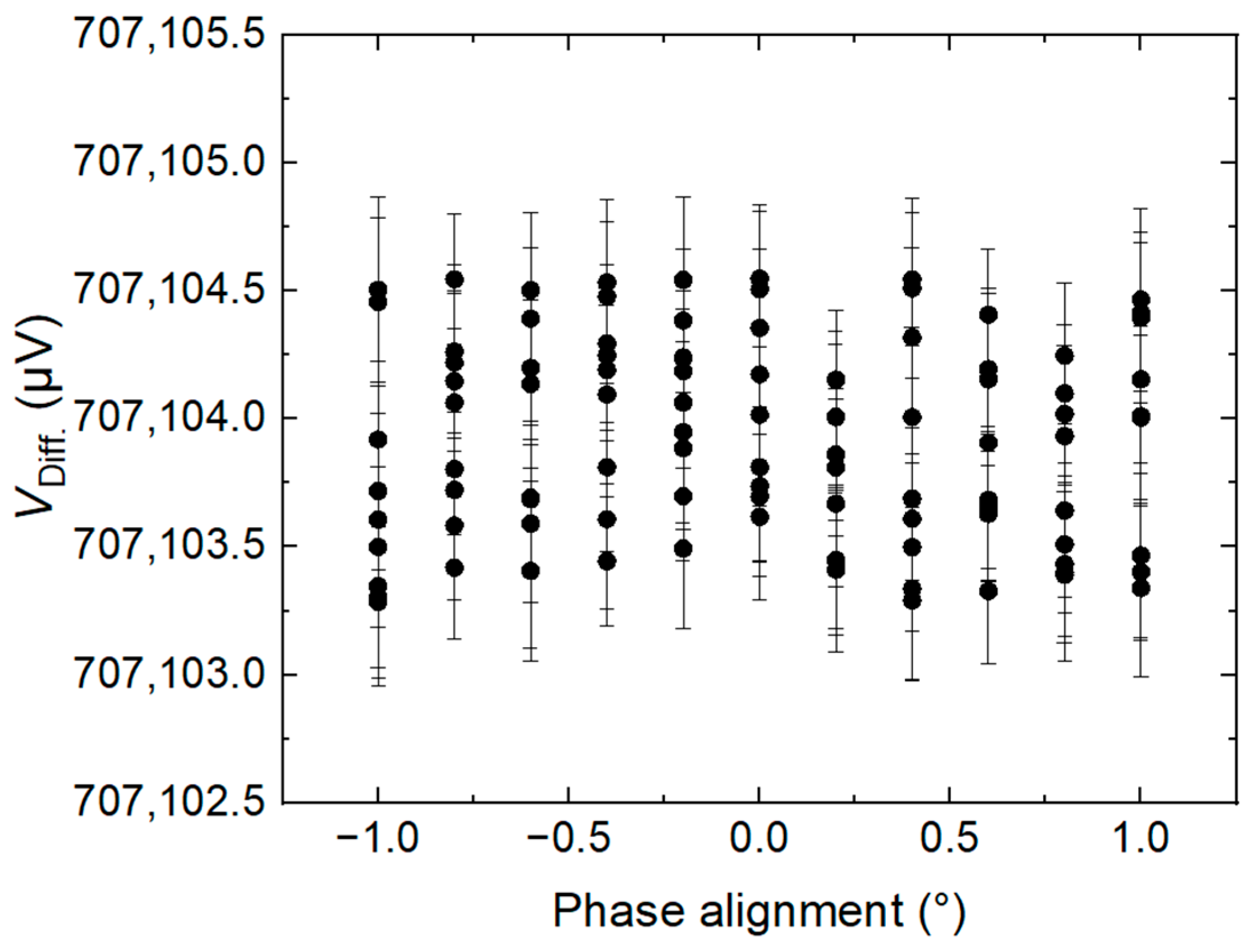
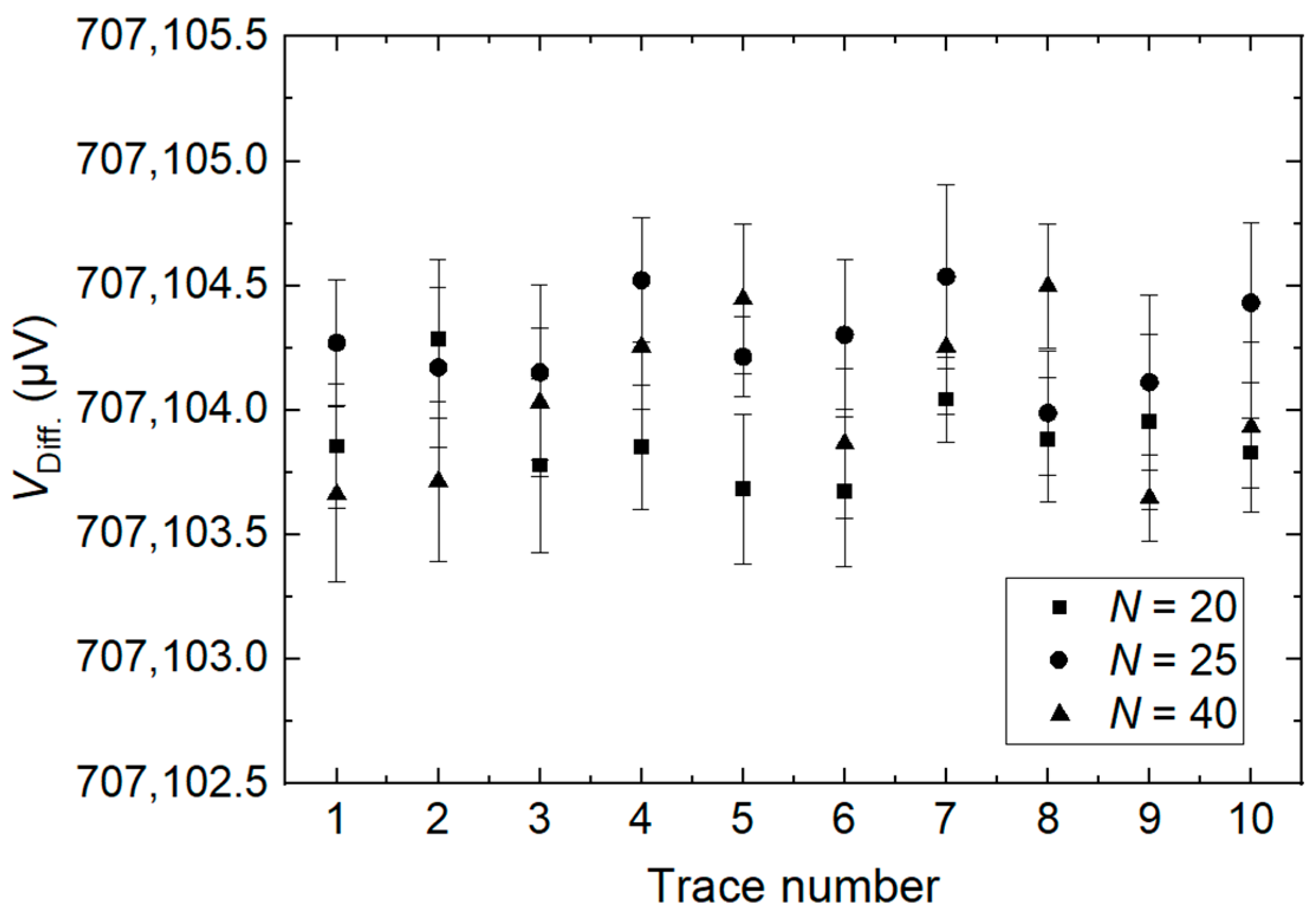

| RMS Amplitude (µV) | Phase (deg) | |
|---|---|---|
| 1f | 707,104.29 ± 0.32 | −0.006 ± 0.0001 |
| 2f | 29.15 ± 0.03 | 115.31 ± 0.10 |
| 3f | 6.52 ± 0.03 | −83.67 ± 0.45 |
| 4f | 0.56 ± 0.01 | −96.10 ± 2.68 |
| 5f | 2.71 ± 0.01 | −119.20 ± 0.96 |
| DC off. | 126.55 ± 0.97 |
| Source of Uncertainty | Component | Type | Uncertainty (μV/V) |
|---|---|---|---|
| Reference voltage (DAC) | Noise of step | A | 0.20 |
| Methodical error | B | 0.20 | |
| Drift | B | 0.01 | |
| Temperature coefficient | B | 0.04 | |
| Calibrator | Noise of calibrator | A | 0.20 |
| Drift | B | 0.30 | |
| Phase error | B | 0.20 | |
| Sampling voltmeter | Noise of sampler | A | 0.10 |
| Common-mode rejection ratio | B | 0.04 | |
| Gain correction error | B | 0.06 | |
| limited bandwidth | B | 0.10 | |
| Combined standard uncertainty | 0.53 | ||
| Expanded uncertainty (k = 2) | 1.06 | ||
Disclaimer/Publisher’s Note: The statements, opinions and data contained in all publications are solely those of the individual author(s) and contributor(s) and not of MDPI and/or the editor(s). MDPI and/or the editor(s) disclaim responsibility for any injury to people or property resulting from any ideas, methods, instructions or products referred to in the content. |
© 2024 by the authors. Licensee MDPI, Basel, Switzerland. This article is an open access article distributed under the terms and conditions of the Creative Commons Attribution (CC BY) license (https://creativecommons.org/licenses/by/4.0/).
Share and Cite
Wang, Y.; Sun, X.; Zhao, J.; Zhou, K.; Lu, Y.; Qu, J.; Hu, P.; He, Q. Differential Sampling of AC Waveforms Based on a Commercial Digital-to-Analog Converter for Reference. Sensors 2024, 24, 2228. https://doi.org/10.3390/s24072228
Wang Y, Sun X, Zhao J, Zhou K, Lu Y, Qu J, Hu P, He Q. Differential Sampling of AC Waveforms Based on a Commercial Digital-to-Analog Converter for Reference. Sensors. 2024; 24(7):2228. https://doi.org/10.3390/s24072228
Chicago/Turabian StyleWang, Yanping, Xiaogang Sun, Jianting Zhao, Kunli Zhou, Yunfeng Lu, Jifeng Qu, Pengcheng Hu, and Qing He. 2024. "Differential Sampling of AC Waveforms Based on a Commercial Digital-to-Analog Converter for Reference" Sensors 24, no. 7: 2228. https://doi.org/10.3390/s24072228
APA StyleWang, Y., Sun, X., Zhao, J., Zhou, K., Lu, Y., Qu, J., Hu, P., & He, Q. (2024). Differential Sampling of AC Waveforms Based on a Commercial Digital-to-Analog Converter for Reference. Sensors, 24(7), 2228. https://doi.org/10.3390/s24072228






